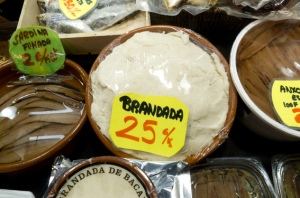Arroz con Conjo is a simple rice dish with rabbit and mushrooms – this is a version of Arroz de Montaña (mountain rice), which sometimes includes snails. Sadly I could only find two (trying to eat my vegetables in the garden). Arroz con Conjo can be cooked in the oven it’s not a paella and my recipe is an arroz caldoso, a wet or soupy rice.
Arroz caldoso is almost certainly a precursor to paella, which is a relatively modern dish, invented in the 18th Century. The Moors began cultivating rice in Spain, perhaps as far back as the 8th and 9th Centuries and the marshes and lagoon of L’Albufera, (in the south of Valencia) proved to be a perfect place for paddy fields (though rice is cultivated all over Spain). Originally rice dishes would have been cooked in cauldrons or terracotta cazuelas – soupy stews of fish or meat, such as a Caldero Murciano or oven baked meat and rice with beaten eggs on top like Arroz con Costra.
Arroz de Montaña (serves 4):
a wild rabbit (jointed)
300g arroz tipo Bomba
1 medium onion (chopped)
6 cloves garlic (chopped)
3 medium tomatoes (grated)
1 red pepper (chopped)
100g mushrooms (chopped)
100g bobby beans (chopped)
1/2 teaspoon dry thyme
3 sprigs fresh rosemary
a large pinch saffron
a teaspoon pimentón de la Vera dulce
a glass of dry white wine
1 litre home made chicken stock
1 1/2 dessertspoons plain flour
sea salt and cracked black pepper (to taste)
chopped parsely (for decoration)
Cut the rabbit into pieces, dust in plain flour (seasoned with a little sea salt and cracked black pepper). Brown in hot olive oil and reserve to a plate. If rabbit is hard to find, do use chicken or squirrel!
Sofregir (underfry or poach) the chopped onion (in the same oil) until it goes soft and sticky.
Push the onion out to the sides and fry the chopped beans.
After about 5 minutes, do the same with the beans and fry the red pepper.
The chopped mushrooms come next and ideally should be wild ones, but closed cap mushrooms will do.
Finally, stir in the garlic and add the grated tomatoes to the middle of the pan.
Mix in the tomatoes and allow the sauce to thicken, before sprinkling on thyme and pimentón.
Pour on a large glass of dry white wine and allow the alcohol to burn off for a few minutes.
Pour the sauce into a terracotta cazuela or oven dish. Mix in the dry Valencian rice (do not wash it!) and make sure it is coated in salsa.
Grind a large pinch of saffron in a small mortar and pestle. Pour on a little boiling water and allow to steep for 5 minutes.
Make sure the chicken stock is hot, mix it into the rice, along with the saffron and sink the rabbit into the broth. Place 3 sprigs of fresh rosemary on top. Check the seasoning and cook in a preheated oven at 200ºC for 30 – 40 minutes, until the rice is al dente. Valencian rice is thirsty, so if it drinks too much, add a little more hot stock.
Meanwhile, make some allioli to acompany the arroz.
When cooked, allow the rice to rest for 5 minutes under newspaper or a tea towel – but no longer! It will absorb all the broth, if left too long. While the dish looks dry on top, you will notice the stock where I’ve removed a portion from the cazuela. Sprinkle the rice with chopped parsley and serve with pan con tomate and a green salad. The sweetness of the red pepper with the rosemary and saffron is particularly delicious! I recommend drinking a glass or two of Piedra Verdejo 2022, an organic white, from D.O. Rueda, with the Arroz de Montaña.
































































































































